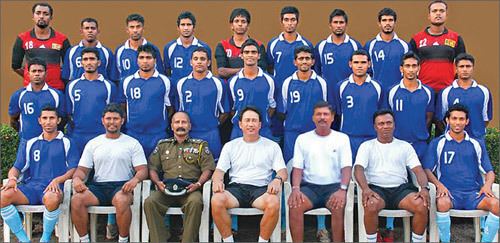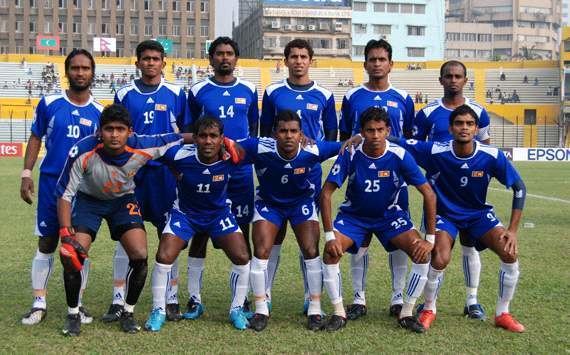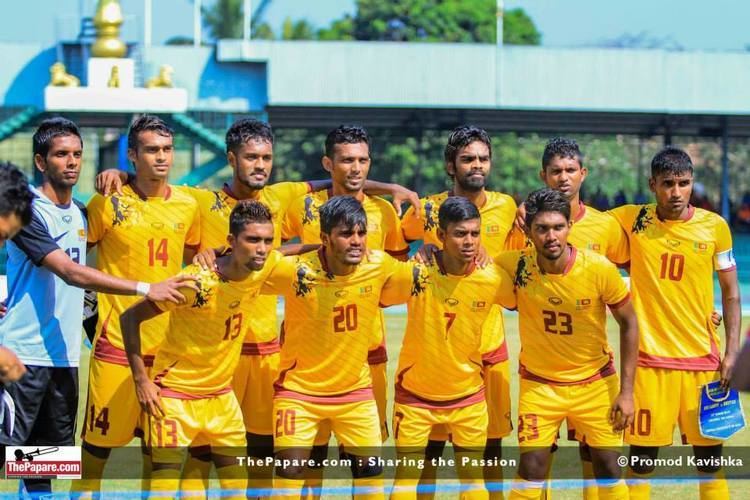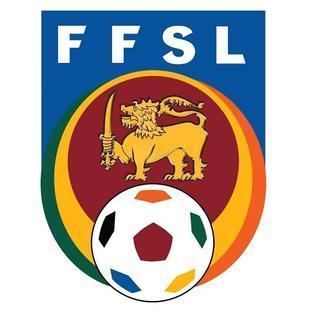Sub-confederation SAFF (South Asia) Current 197 1 (9 March 2017) Founded 1939 | FIFA code SRI Highest 122 (August 1998) Captain Sujan Perera | |
 | ||
Confederation Asian Football Confederation (Asia) Arenas/Stadiums | ||
India vs sri lanka highlights saff championships 2011
The Sri Lanka national football team represents Sri Lanka in association football and is controlled by the Football Federation of Sri Lanka, the governing body for football in Sri Lanka. Sri Lanka's home grounds are Sugathadasa Stadium and Kalutara Stadium. The Sri Lankan team was known as the Ceylon national football team until 1972, when Ceylon was renamed Sri Lanka.
Contents
- India vs sri lanka highlights saff championships 2011
- Early history
- First international tour in 1957
- 1990s to present
- Media coverage
- Colours
- Sugathadasa Stadium
- Kalutara Stadium
- Current squad
- Recent call ups
- 2016
- All time records
- AFC Challenge Cup
- Honors
- References

A member of the AFC, the team has yet to make their first appearance in FIFA World Cup or AFC Asian Cup finals. They have been South Asian champions once, in 1995. As is true elsewhere on the sub-continent, top-level football in Sri Lanka stands somewhat in the shadow of the country's test cricket team. However, the side did reach the second qualification stage for the 2006 FIFA World Cup. In the same year they became the runners-up in AFC Challenge Cup 2006.

In 2014, at the 75th anniversary of FFSL, FIFA President Sepp Blatter visited Sri Lanka and opened a new football stadium in Jaffna. During the visit Blatter said he was not pleased with the development of Football in Sri Lanka and that the authorities haven't taken enough steps to support football on the island. The AFC President Sheikh Salman Bin Ibrahim Al Kalifa also joined the visit.

In the qualification round of 2018 FIFA World Cup, Sri Lanka lost both matches against Bhutan. This was the first time that Sri Lanka lost a game against Bhutan, and Sri Lanka failed to qualify for the next round. After a long period of poor performance in international football, Sri Lanka national football team had managed to qualify for the semi-finals of the 2015 SAFF Championship.
Early history
Football was introduced to Sri Lanka by the British when Sri Lanka, then known as Ceylon, was a colony of the British Empire. There is evidence of the game being played in the sprawling sandy stretches familiarly termed as Galle Face, by bare chested British Servicemen stationed in and around Colombo in the 1890s. The service barracks grounds at Echelon Square where the Galadari Meridian Hotel stands and the Army grounds (presently the Taj Samudra Hotels) were the popular football fields in the game's formative years.
British service units such as Royal Air Force, Royal Navy, Royal Engineers, Royal Artillery and the Royal Garrison Command were the pioneers who promoted competitive football in this country. The British administrative service and the British planting community took the sport to the Central, Southern, and Up-Country regions with the equal zest and fervor. By early 1900 football as a competitive sport, was popular amongst the local youth. Though playing bare feet, the native players had mastered the skills of the game, and in fact, donned the Services Jerseys as replacements or reserves in many an exclusively white dominated team.
The game grew popular leading to the formation of local football clubs. Some of the first clubs in Colombo were St. Michael's SC, Havelock's Football Club, Java Lane SC, Wekande SC, Moors FC and CH & FC, the last being exclusively a European monopoly. Harequins FC and Saunders SC soon joined. The trophies of the principal tournaments of that era were the De Mel Shield and the Times of Ceylon Cup. Southern Provence – the sport had a fair impact on the masses, with the planting and administrative community leading the promotion of the game in a big way. T R. Brough a British planter in Deniyaya contributed much to the game in the South between 1910–1920. The British Servicemen from the Navy wireless station in Matara also helped to popularise the sport.
Sri Lanka became a member of FIFA in 1952 and got the opportunity to play football in the international level.Sri Lanka played their first International friendly with their neighbouring country India.Then Afootball tournament called Colombo Cup was oraganized by the Football federation and it helped the Sri Lankan team to improve their skills and compete with the pther nations.As from 1960s The u19 football team competed in the AFC u19 championship.
First international tour in 1957
Tom Ossen, a product of Dharmaraja College, was the man who led the Sri Lanka football team in the first ever tour of the Far East in 1958. During that period, Tom Ossen was attached to the Kandy Municipal Council as playgrounds master and played football for Young Stars Sports Club and Kandy League.
Though he is no more, his service for football is remembered. In 1958 when the Sri Lanka Football team toured far east. It was Tom Ossen who was invited to lead the country. Later he was the coach of the Peradeniya University, Kandy Association Football League and a top grade FIFA referee. He handled the whistle in many games, at club and International level. In the good old days, tours were limited, not like today. Nowadays there are plenty of tours, thanks to Manilal Fernando who opened the good will gate for overseas tournaments in Sri Lankan football. This first ever tour took place in 1958, where a twenty-member team left the Katunayake Airport on a six weeks tour of China via Rangoon. This tour was organized by the Chinese Embassy in Sri Lanka. At that time football was the most popular sport in the country.
Tom Ossen who had been playing for the country from 1952, was a top class player. He was famous for ball control and also was a team man. Before this tour, Tom led the Sri Lanka team against Madras. At that time football matches were played against Indian teams like Madras, Mysore, Hyderabad, Delhi etc. After Manilal Fernando came, our teams toured every where football is played. On this tour of Far East, Tom's deputy was Andrew Fernando, who was just a year junior to Tom at National level. In the previous year, 1957 Andrew Fernando had helped the Lankan team to beat Burma together with another Kandy product T.O.M Marikar Deen. These two netted a goal each to give the country two goals to Burma's no score. It was M.M. Hashimdeen of Victory FC and Ben Ferreira of Southern SC Galle who were the two goal keepers, Hashimdeen then known as the "Prince of goal keepers" had thrilled the spectators, on our soil and overseas with his superb job between the post.
The fullbacks were Christopher Ranasinghe, Bagoos Saldin, E.P. Solomon and Christopher Ransnghe, the last named had played for Sandhurst and the Army Southern Command. He was a fine fullback with powerful kicks. Bagos Saldin played for Old Joes SC was a crack fullback and E.P. Solomon played for Saunders FC, was the best left back at that time.Besides Tom Ossen the captain, the other halves were M.P.B. Dissanayke, K.A.Premadasa, Eric Perera, and M.A.Karunarthne all were excellent players. The later was known as the most scientific and stylish half-back in the Sri Lankan and Asia. M.P.B.Disanake played for All-In-One SC and then Erick Perera of Suanders FC was another fine player. M.A.karunarthne was a product of Badulla.
The forwards line up were right extreme T.S. Jayman, the third product of Kandy in the team, came from Kingswod College Kandy who played for CR & FC. Then the left extreme was B.Ariyadasa of Sunders FC, who was also well known for his hard work. K.D.Soapal of Kotehena was tight inside, T.O.M. Mariakr Deen was the center forward. Left inside place was occupied by Policemen L. Bernadus Jnr from St.Benacict's College, and he also played for Rowland's SC. The team was under the watchful eyes of D.S. Abraham and this was the twenty which was on the historic tour.
1990s to present
1995 SAFF Championship was the second SAFF Championship Tournament which was named as 1995 South Asian Gold Cup. The five countries participating in this tournament were India, Sri Lanka, Bangladesh, Nepal and Pakistan. Sri Lanka was the host of the South Asian Gold Cup for the first time. Sri Lanka was placed in the Group B with India. The match between Sri Lanka and India ended with a 2–2 draw. Mohamed Amanulla scored both goals for Sri Lanka, the second goal due to a penalty. Sri Lanka qualified for the semi-finals. In the semi-finals Sri Lanka played against Nepal. Sri Lanka beat Nepal 2–1 in extra time to qualify for the finals. The Final was held between Sri Lanka and India. Sri Lanka beat India 1–0 and won their first championship title in football. Sarath Wellage scored the winning goal in the 108th minute.After a goal less first half, the heavens opened and lighting flashed all around the stadium. Surely the match would have to be abandoned under such conditions and the teams would have to share the prize as joint champions. All credit went to George Joseph, the AFC's match commissioner from the Football Association of Malaysia. After consulting the local officials he held on for 45 stormy minutes until the rain relented.
Incredibly, the players were back out within a couple of minutes and the second half kicked off on a pitch which looked once the worse for the watery battering it had just taken.No goals were scored in the 90 minutes, no sudden-death winner in the first period of extra time. Yet again found one, a Kandy product Sarath, who came into the game as a substitute on the 68th minute, for his first senior cap. In the 108th minute, skipper Sampath Perera broke down the left and his low cross was met by Sarath, whose diving header flew into the far corner. Match over. The 2006 AFC Challenge Cup was the first AFC Challenge Cup tournament that was held by the Asian Football Confederation. This tournament acted as a qualification for the AFC Asian Cup and was held in Bangladesh. Sri Lanka became the Runner Up in the 2006 AFC Challenge Cup after losing the final against Tajikistan with 4–0. Sri Lanka failed to qualify for the AFC Asian Cup but received the fair play award.
After a poor display in 2013 SAFF Championship which defeated to Maldives 10–0 many chaos were came to the future of Sri Lanka's football future. In 2014 the newly elected FFSL president Ranjith Rodrigo resign all the players in that time and made a new team with new players.As a result, The National team had to suffer a huge defeat against the lowest rank football team Bhutan in both legs and blawn away from 2018 FIFA World Cup qualifiers.
In 2015 Sri Lanka played for the first time in the Bangabandhu Cup. This tournament was organised by Bangladesh Football Federation. The national U-23 TEAMS of Thailand, Bahrain, Malaysia and Singapore participated in this tournament. The national football teams of Bangladesh and Sri Lanka also competed in this tournament.
Sri Lanka was placed in the group with Malaysia and Bangladesh. In the first game Sri Lanka played against the Malaysian team. Malaysia won the match by 2–0. The second match was played against the host Bangladesh. Sri Lanka lost the game 1–0. Sri Lanka failed to score a goal in this tournament. After a six years of poor performance in the international football field Sri Lanka football team managed to qualify for the Semi Final of 2015 SAFF Championship.The poor performance continued in the Solidarity Cup as well.They had another shock defeat this time by the hands of Mongolia the lowest ranked team in asia.As a result of this defeat Sri Lanka eliminated in the Group Stage of the tournament.
Media coverage
There is no official broadcaster for the football matches that played by Sri Lanka because the FFSL didn't sell broadcasting rights.But the SAFF Championship had been shown by different channels.The tournaments in 1990s and 2000s were broadcast free to air by Channel Eye.The 2013 SAFF Championship was broadcast by CSN.
Star Sports have broadcast the SAFF Tournament in pay tv on satellite broadcasters.The Papare.com is the official online broadcaster of sri lanka football matches which broadcast the Sri Lanka Football Premier League,Finals of Sri Lanka FA Cup and The schools u-19 championship also through the internet.
Colours
The traditional national team's home kit has mostly been maroon shirts and maroon shorts, but blue colours have also been used. The colours are derived from the 15th century flag of Kingdom of Kandy. The away shirt colour has changed several times. The Sri Lankan team used white shirt with white shorts or black shirt with black shorts. Historically, white shirt with white shorts is the most often used colour combination. The kits are currently manufactured by Grand Sport Group.
Sugathadasa Stadium
Sugathadasa Stadium is the former athletic stadium in Sri Lanka. It was established in 1972 and has a capacity of 28,000. The stadium is mostly used for athletics and football. The 1995 and 2008 SAFF Championship tournaments were held in this stadium.This is the home stadium of Sri Lanka National Football Team.Sri Lanka won their first major football tournament in his stadium.It was defeating India in the Final of 1995 SAFF Championship.
All the FIFA World Cup qualification matches of Sri Lankan team also played in this ground.This ground has become a lucky ground for Sri Lanka team because they have won much of the matches played in here.The draw against Philippines Football team and The Tajikistan Team were well known.In recent times Sri Lanka lost to Bhutan in 2018 FIFA World Cup qualify matches against Bhutan in this Stadium.The 2014–15 FA Cup Final also held in this ground.
Major football tournaments that played in here were the AFC President's Cup and AFC Challenge Cup.
Kalutara Stadium
Kalutara Stadium is a multi-use stadium in Kalutara, Sri Lanka.This stadium also known as the Vernon Fernando ground. It is currently used mostly for football matches and hosts the home games of Kalutara Park SC. The stadium holds 15,000 people.This stadium is popularly known as "Kalutara Park Ground".This stadium is located in the heart of Kalutara city.This stadium is mostly use in the Sri Lanka Champions League and Sri Lanka FA Cup tournaments.
Current squad
All the caps and goals are correct as of 1 December 2016
Recent call-ups
The following players have been called up to the Sri Lanka squad in this year.
2016
Win Draw Lose
